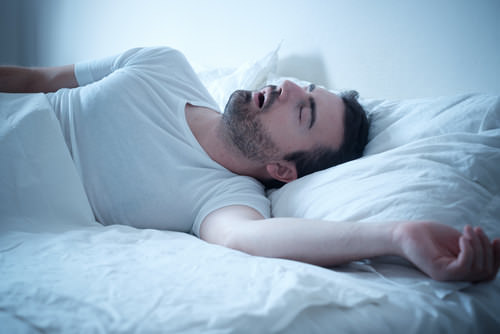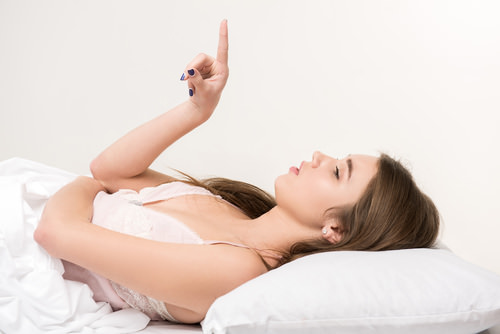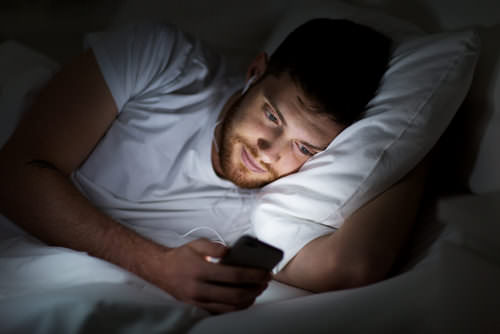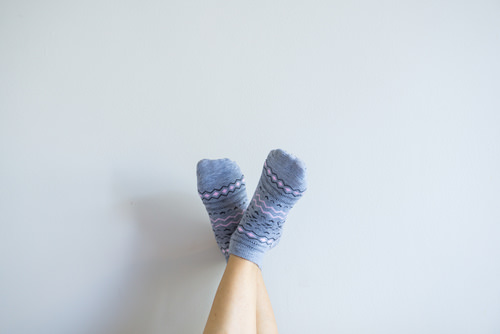
Tossing and turning, the ticking clock, an anxious mind — is there anything worse than insomnia?
A good night’s sleep is defined by the quality, not the quantity, of hours slept. With that said, thousands of people tuck into bed each night only to find that they can’t achieve either. Below are 50 sleep hacks based on science. From warming your feet to eating pineapple before bed, these 50 hacks are sure to slow your mind (if not the clock), and lead you towards a better night of rest.
Avoid big meals right before bed.
Big meals can lead to indigestion, which will definitely lead to discomfort during sleep. Avoid this by eating any large meals a minimum of 2-3 hours before bedtime. The same goes for spicy foods, cigarettes, alcohol, and caffeine.
If you’re hungry, snack wisely.
If you must eat something before going to bed, skip anything big and heavy and go for something like whole grain crackers, peanut butter, cereal with almond milk, almonds, or yogurt. These types of foods consist of tryptophan (which urges the brain to produce sleep-inducing serotonin) and carbohydrates, which rush the tryptophan to your brain.
The perfect nightcap is made from bananas.
Bananas — especially the peels — are chock-full of magnesium, a calming property. A single banana can also boost the production of melatonin in your brain by 180%. As you’re going through your relaxing before-bed routine, sip on some banana tea. First, take a whole banana and cut off the tips. Then, with peel on, boil the banana for five minutes in four cups of boiling water. Finally, steep your banana tea for another five minutes before adding some honey and cinnamon. If you’re not a banana person, that’s okay too. Decaffeinated green tea also contains properties that calm the nervous system and lead to feelings of sleepiness.
A before-bed routine is key.
Following a relaxing routine each night before bed can go a long way in helping you to fall asleep quickly. Whether your routine includes journaling, reading a book, or something else entirely, just make sure it doesn’t include a bright screen, which can stimulate the brain and push away feelings of sleepiness. In general, you should begin winding down at least one hour before you plan to fall asleep.
Fall asleep at the same time each night.
Train your brain to anticipate sleep by making bedtime the same time each night.
Eat dinner at a set time, too.
While this one can be difficult depending on your work and home situation, eating dinner at the same time each day will regulate melatonin, leptin, and other hormones that regulate your sleep cycles.
Don’t work in bed.
While a relaxing activity like reading a book can be calming before bed, other activities like work should always be done somewhere else. The goal is to associate your bed with sleep, and this will never happen if you’re also using it as a home office of sorts.
Turn on some music.
Studies have shown that not only does softly playing music help you to fall asleep, it also improves sleep quality in those with chronic sleep disorders. So put that CD player back to work or download a classical music station on Pandora, and settle in for the night. Why classical? Those same studies have shown that music by Mozart, Bach, Strauss, Handel, and Brahms slow brainwaves into a more meditative mood.
Go to sleep prepared for the next day.
Anxiety is one of the main reasons people have trouble falling asleep. Curb some of this anxiety by taking some time in the evening to prepare for the next day. Pack your lunch, lay out your outfit, and make a quick list of things you want to accomplish.
Don’t go to bed angry.
It turns out there is some truth to this old adage. The journal “PLOS One” published a 2015 article detailing the ways in which negative emotions can reduce REM sleep. The article suggests solving any conflicts before you begin to prepare for bed, or at the very least, mutually agreeing to table the conflict until the next day.

Instead, end your day with the positives.
A 2017 study found that sharing positive news from your day with a loved one, and receiving a positive response, leads to falling asleep much faster.
Figure out if sharing your bed with a pet is right for you.
There is no right answer for this one. While some scientific studies have shown that people sleep better with their pet sharing the bed, others, including a 2015 poll conducted by the Mayo Clinic, have found that some 20% of people find that their pet’s snoring and wandering disturb their sleep. Says one sleep expert, “Everyone has a different tolerance level for pets in the bedroom […] If pets don’t disturb anyone’s sleep, then there’s usually no harm.”
Dog hogging your bed? We can help with choosing the perfect dog bed for your pooch!
Hit the sack by 11 P.M.
That’s around the time the human body experiences a cortisol surge in an effort to stay awake longer. To avoid this extra boost of natural energy, wind down and turn off lights before 11 P.M.
Set the thermostat to a cool 65 degrees.
Studies have shown that the perfect sleeping environment is a cool one — specifically 60 to 67 degrees Fahrenheit. Sleeping in a cool room will help the body’s temperature decrease, which happens naturally as you fall asleep.
Taking a bath right before bed will help.
The potential for relaxation isn’t the only reason sleep experts recommend taking a bath right before bed. While a bath or shower will raise your body temperature, that temperature rapidly drops as you climb out of the warm water. This decrease in temperature notifies the brain that it is time for bed.
Eat some pineapple before you attempt any sleeping pills.
A study done by Thailand’s Khon Kaen University found that eating pineapple could boost a brain’s production of melatonin — the hormone that makes us feel sleepy — by a whopping 266% percent. The brain naturally begins producing melatonin around 9:00 P.M., so eating pineapple around that time, or just before, could prepare you to fall asleep easily.
Hide your clock.
If you’re one to constantly re-count how many hours of sleep you can get throughout the night, it might be best to hide your clock. If you need an alarm clock, put it on the other side of the room where you’ll be able to hear it without seeing it. Doing so will help break the habit of clock watching and decrease feelings of anxiety.
Get rid of the digital alarm clock.
Alarm clocks can cause all kinds of stress, but a digital alarm clock happens to be especially bad for the person who already has trouble sleeping. This is because the bright lights on the clock face can actually cause the decline of important chemicals needed to sleep well.
While you’re at it, get rid of other lights, too.
Those aforementioned important chemicals don’t just decline because of digital alarm clocks; any light can disrupt a good night’s rest. Solve the problem by investing in blackout curtains or wearing eye shades. You may even consider painting the walls of your bedroom a deep navy or hunter green. The darker your sleeping environment, the better you’ll sleep.
Quiet sleeping conditions are ideal.
Just like light, noise can also play a part in keeping you from a restful night of sleep. According to sleep experts, even the slightest sounds made 10-15 minutes before you fall asleep can negatively affect you. Ear plugs, fans, humidifiers, or a white noise machine (there’s even an app for that) can help drown out the more minor sounds, while more distracting sounds — such as the snores of a partner — might merit a move to the guest room.
Progressively relax all of your muscles.
Consciously relaxing all of your muscles is one tactic to try when it comes to falling asleep. You can focus on different parts of your body and relax them one by one, or tense an entire region of muscles and slowly relax from there.

Play a mind game to fall asleep faster.
Whoever first thought up the idea of counting sheep was on to something. According to a study conducted by the Journal of Applied Social Psychology, people who challenged themselves to a not-so-exciting mind game not only fell asleep faster, but slept a whopping 62% longer than those who didn’t. Some suggested games include thinking of sleep-related words or counting backward from 400 by fours.
Attempt the 4-7-8 breathing method.
The 4-7-8 breathing method is simple, and some sleep experts claim using this method will make you fall asleep in less than one minute. Start by inhaling through the nose for four straight seconds. Then hold your breath for seven seconds before taking a full eight seconds to exhale through your mouth. Repeat this process as many times as you need to.
Massage your supraorbital nerve.
Massaging this nerve, located right above your eyelid, can help to relax the muscles in your head, face, and neck, while also easing the mind.
If you wake up during the night for more than 20 minutes, find something to do.
Tossing and turning in an attempt to fall back asleep is worse than losing an hour or two of sleep. If you wake up in the middle of the night, and spend more than 20 minutes trying to fall back asleep, just get up. Find something to do that will tire out both your hands and your mind. Just make sure your chosen activity doesn’t include a bright screen or light. Good activities include having sex, reading a book, quietly thinking, and journaling.
Sleep on a comfortable mattress.
High quality mattresses are only meant to last about 9 to 10 years, and as they age, they begin to lose much of their support. Ensure you’re setting yourself up for the best sleep possible by making sure your mattress is supportive enough for comfort.
Replace pillows frequently.
Like mattresses, pillows become less supportive over time. They also begin to collect dander and other allergens that can really affect the process of falling asleep. An inexpensive polyester pillow should be replaced every six months, while a memory foam pillow should be re-purchased every 18 to 24 months.
Wear warm socks.
Falling and staying asleep could be as simple as donning a pair of warm socks. The National Sleep Foundation reports that heating your feet with wool, cashmere, or fleece socks can dilate your blood vessels, which then signals the brain that it’s time to go to sleep. In general, the more dilated vessels you have in your hands and feet, the faster you can begin to doze.
Fan yourself to sleep.
Get this: a fan constantly blowing air on you as you fall asleep stimulates the tiny hairs on your body until they reach such a state of overstimulation that they shut down the sympathetic nervous system altogether. This same phenomenon that allows you to hardly notice you’re wearing clothing also allows you to sleep more deeply.
Fall asleep with a pillow under your knees.
Oftentimes, people have trouble falling asleep because their lower back is in an uncomfortable position. If you experience such discomfort, solve the issue by falling asleep on your back, with a pillow under your knees. Doing so will lift your legs enough to allow your lower back to rest comfortably on the mattress. If this proves insufficient, lay on your back and rest your legs in a crossed Indian style atop the pillow.

Don’t sleep near your phone.
When you tuck in for the night, make sure your phone is somewhere else entirely, or at least on the other side of the room. A report done by Ofcom in 2014 found that 80% of people keep their phones next to them when they sleep, but this is not recommended. Besides being a major distraction, your phone emits a blue light that, like sunshine, acts as a stimulating effect.
Wake up at the same time each morning.
As tempting as it is to sleep in on weekends, waking up and going to sleep at the same time each and every day will help to regulate your body’s natural clock, so you can fall asleep faster and stay asleep throughout the night.
Make your bed after waking up.
Believe it or not, keeping your bed neat and tidy can actually help you sleep better. For starters, making your bed each morning means starting your day with an accomplishment and ending it with comfort. But perhaps more importantly, making your bed keeps dust, pet hair, and wrinkles out of your sheets, all of which can disrupt sleep and even damage your skin.
Spend your morning in the sunshine.
Having healthy circadian rhythms means you are well-rested and energized in the morning, yet tired enough to fall asleep within 10-15 minutes at night. To help keep your circadian rhythms in check, grab some sunshine in the morning time, and avoid bright lights during evening hours.
Exercise daily.
Exercise has a number of health benefits, including contributing to a healthy sleep schedule. You can run 10 miles or take a walk around the block. Either way, sleep experts say that just two and a half hours of moderate exercise per week is enough to improve your sleep.
Avoid taking a nap.
Resisting the temptation to nap can be a battle, especially come 2:00 P.M. when your body experiences a natural dip in energy. But avoiding naps, even cat naps, can help to ensure you’re not still bursting with energy come bed time.
If you really must nap, make sure it’s between the hours of 1:00 and 3:00 P.M.
Your body experiences a natural dip in energy around 2:00 P.M., so if you really must take a short nap, this is the time to do it. Just make sure you’re not lying down after 3:00 P.M., as that could leave you with too much energy come bedtime.
Down a cup of coffee before that necessary catnap.
Wait, what? Caffeine takes approximately 20 minutes to kick in, so drinking coffee right before that catnap will mean a burst of energy upon waking up — just what you need to both get through the rest of the afternoon, yet still fall asleep for the night at a reasonable hour.
Use coconut charcoal to get your circadian rhythm back on track.
If your usual sleep cycle is disturbed — perhaps by traveling to a different time zone or temporarily working a different shift at work — the bacteria in your gut will create more endotoxins and give you those feelings of “jet lag.” Capture, bind, and remove these unwanted endotoxins with coconut charcoal.
Leave your problems (and some solutions) on paper.
Problems weighing on the mind is one of the biggest reasons that people have trouble sleeping. A recent study published in “Behavioral Sleep Medicine” found that people who wrote down their problems along with a few possible solutions were more relaxed upon going to bed than those who allowed their issues to continually weigh them down.
Use mindfulness meditation to leave your stress behind.
Another way to ensure you’re going to bed sans stress is to partake in some mindfulness meditation. The British Psychological Society recently conducted a study among insomniacs that found that this type of meditation was just as effective as taking a prescription sleep aid. If you’re not totally sure how to approach mindfulness meditation, don’t worry, there’s an app for that.

A simple yoga move can slow down both your heart rate and your racing mind.
Reduce muscle tension, slow your heart rate, and ease your mind with a simple yoga move you can do in bed. Simply lie on the bed and lift your legs up onto the wall. Your feet can touch or flop out to the side. Your arms should be open out like wings, with palms up. In this position, close your eyes and count to four while inhaling slowly through your nose. Ten minutes of this should lead to enough relaxation to fall asleep comfortably.
Hypnotherapy works too.
In 2014, “Sleep” conducted a study which found that women who listened to an audio tape that promoted sleep and contained hypnotic suggestions spent about 80% more time in deep, REM sleep than those who didn’t receive hypnotic direction. There are a number of sleep-promoting hypnotherapy apps available, including the therapist-designed Sleep Deeply app.
Skip the LED lightbulbs in the bedroom.
Despite the massive shift towards energy efficient LED lightbulbs, sleep expert Jennifer Adams insists that the “old fashioned” halogen or incandescent bulbs are best for the bedroom. This is because LED lights are so bright that they mimic daylight, throwing off one’s circadian rhythms and making it difficult to fall asleep.
Decorate your bedroom with calm, solid colors.
According to sleep expert Jennifer Adams, the colors most conducive to sleep are those that are soft and muted, specifically whites, beiges, grays, blues, and sages. On the flip side, bright colors and loud patterns are not recommended.
Keep the rest of your bedroom decor simple, too.
Limit your bedroom furniture to a bed, nightstands, a chair, and something simple at the foot of your bed like a small sofa or bench. Adding things like a desk or workout equipment will only invite feelings of stress, while reflective elements such as mirrors will only serve to jar the senses in the dark.
Use candles to create a soothing environment.
A candle or air freshener can help to create a calming environment and soothe you to sleep. Just make sure you’re choosing a fragrance such as lavender, which is calming, as opposed to something more energizing like citrus.
Try taking melatonin.
Melatonin is a natural hormone that a 2013 research review found can help people reset their circadian rhythms and fall asleep faster. A mere 0.3 to 0.5 milligrams a couple hours before bedtime can work wonders, but like when taking any natural herbs, you should check with your doctor to ensure that melatonin will not interact negatively with any medication already being taken.
Quit smoking.
Not only is smoking bad for your physical health, but it also affects the brain and lungs to the point of causing sleep disruption. Besides insomnia, smokers often experience sleep apnea, more frequent wake ups, and restless feet in the morning.
Last, but not least, Have more sex.
Besides helping to lessen feelings of depression and anxiety, the act of sex releases a bevy of sleep-friendly hormones, including prolactin and oxytocin, which bring on drowsiness and lower stress levels, respectively. But there’s more! A 2015 study found that female participants who were able to get an additional hour of sleep each night for two weeks had a higher libido and an increased chance of having sex the next day.
Additional Resources on Common Sleep Questions
- How Long Is a Sleep Cycle?
- How Many Hours of Sleep Should You Get?
- How Much REM Sleep Do You Need?
- How Much Sleep Is Too Much?
- How to Fix Sleep Schedule
- How to Get More Deep Sleep
- Hypnosis for the Struggling Sleeper
- Sleep Tips: The Complete Guide to a Better Night’s Sleep
- What Is the Best Temperature for Sleep?
Sources
National Sleep Foundation
HuffPost
BuzzFeed
Health
Developing Good Habits
Ghostbed
Wonder How To
Tim Ferriss
World of Lucid Dreaming
The Telegraph Lifestyle
Philips USA